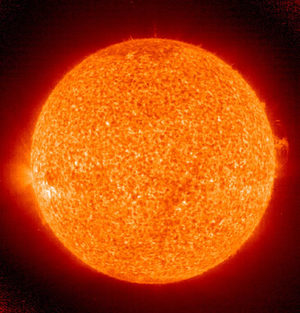For anyone stuck on a casino stool, playing hours of video poker, rest assured: humans can still beat a computer.
But computers may soon dominate on the felt-top table, as they have on the chessboard.
In a match of wits between man and machine this week, a software program running on an ordinary laptop computer fought a close match, but lost to two well-known professional human poker players.
The contest, which was billed as the "First Man-Machine Poker Championship" and which offered prize money totaling $50,000, pitted two professionals, Phil Laak and Ali Eslami, against a program written by a team of artificial intelligence researchers from the University of Alberta. They gave it a name that probably no gambler would ever choose as a nickname, Polaris.
A stunning new image of the Sun has been released by NASA which shows it as an almost perfect sphere, glowing a fiery red and orange in the pitch-black of space.
It is almost spotless, a sign that the Sun may have reached solar minimum. Scientists are now watching for the first spot of the new solar cycle to appear.

|
| ©NASA
|
| The sun, as photographed by NASA's SOHO spacecraft.
|
Scientists thought that most new genes were formed from existing genes, but Cornell researchers have discovered a gene in some fruit flies that appears to be unrelated to other genes in any known genome.
A team of Greek paleontologists have discovered the tusks and fossilized remains of a 3-million-year-old mammoth-like mammal in Grevena, northern Greece.
The mysterious archaeological ruins from where the Dead Sea Scrolls were discovered 60 years ago served first as a fortress before being adopted by Jewish religious sect, two UCLA researchers contend.
"Qumran was established originally as a fortress, just as the archaeological evidence shows, and then it was abandoned," said Robert R. Cargill, a UCLA graduate student in Near Eastern Culture and Languages. "It was later resettled by the Essenes, an early Jewish religious community that came from Jerusalem, bringing with them the scrolls and continuing to copy and compose new scrolls."
Dan Vergano
USA TodaySun, 22 Jul 2007 09:03 UTC
Unicorns, giants and fairies - the UFOs of antiquity - have yet to turn up in any archaeologist's shovel.
Aside from their frequent appearances on ancient frescoes, statuary and artwork, such fanciful creatures of mythology don't have a clear origin, although some have linked the mermaid to lonely sailors who glimpsed dugongs (also known as sea cows) in the distance and made a giant leap.
But a recent discovery in an Iranian salt mine, one scholar suggests, may shed light on the origins of a famous satyr of antiquity, one so well known that it merited a visit from the emperor himself. The satyr is a goat-man in Greek legend who dances and frolics, playing pipes and chasing nymphs all day, living in a woodsy version of the Playboy Mansion.
An ambitious mission to uncover the past of the Solar System
A new space rock has been found that devotedly travels around with Mars as it orbits the Sun, bringing the total number of such 'groupies' to four. But astronomers say it was Mars - not its tiny companions - that originally insinuated itself into the rock group billions of years ago.
The asteroid, called 2007 NS2, was discovered by astronomers at the La Sagra Observatory in southern Spain on 16 July. Based on its brightness, it is estimated to be about 1 kilometre across.
The twin rovers on Mars are in good shape today despite widespread dust storms that worsened last week and threatened to cut off solar power to the robotic explorers.
Steve Squyres of Cornell University, the lead scientist for the Mars Exploration Rovers (MER) project, said that both Spirit and Opportunity are in "excellent shape" based on a radio transmission received this morning.
"Both came through the weekend beautifully," Squyres said in a telephone interview. "They were both power positive over the weekend, meaning they were generating more power than they were consuming."
The amount of sunlight penetrating the dust-choked martian atmosphere has increased slightly in recent days, and the batteries of both rovers are fully charged, said Michael Meyer, lead scientist for the Mars Explorations Program at NASA Headquarters in Washington, D.C.
Astronomers measure atmospheric opacity in units of "tau." The lower the tau value, the clearer the sky.
It's sleek. It's chic. It's very, very, very tight. All the better to show an astronaut's gravity-defying figure back on earth.
Introducing the BioSuit: a prototype spacesuit recently completed by scientists at the Massachusetts Institute of Technology.
When the white high-tech design is finalized in a few years, it will be the first new look for astronauts in more than four decades, replacing the lumpy, awkward 300-pound outfit with something worthy of a super hero.
"The current spacesuit dates back to Apollo," said Robert Cassanova, director of the NASA Institute for Advanced Concepts, which partially funded the work. "It's a gas-pressurized bag that provides the atmospheric pressure humans need to survive, but they're heavy and bulky." The Michelin-man-like outfit is also exhausting -- about 70 percent of the energy astronauts expend is spent wearing the suit.
